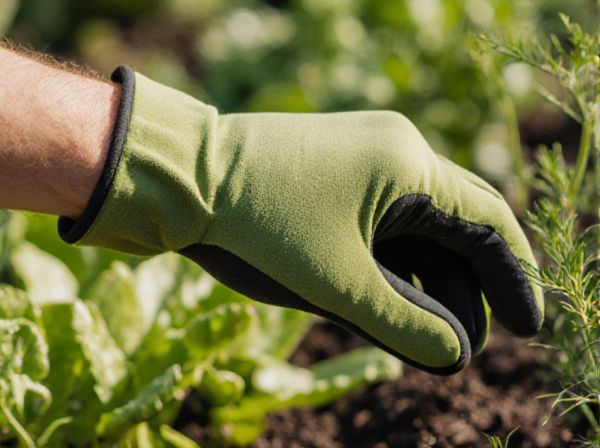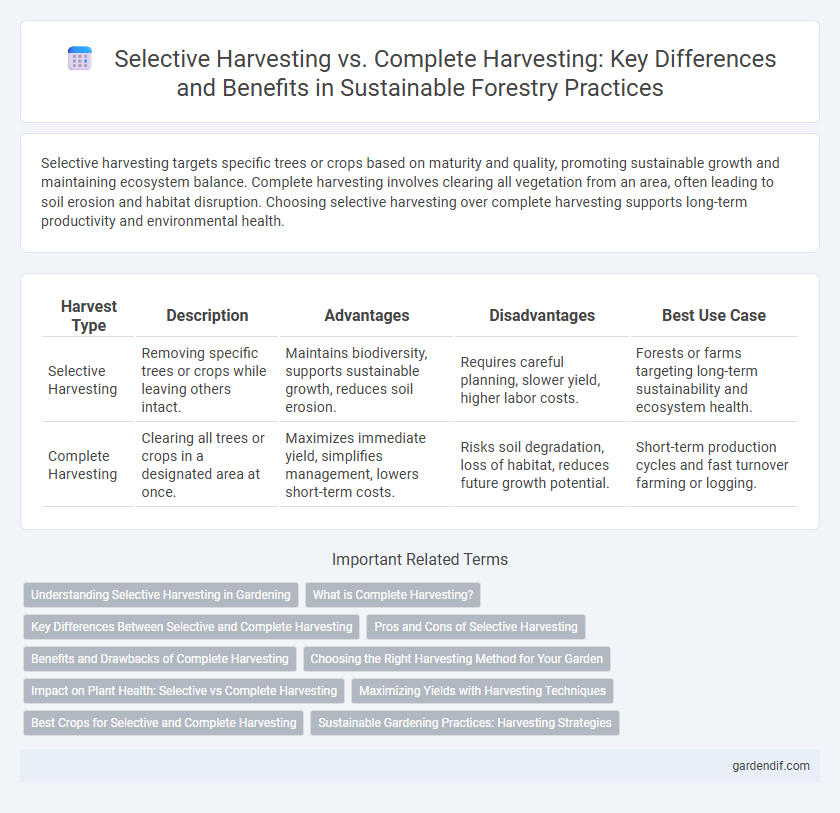
Selective Harvesting vs Complete Harvesting Illustration
Selective harvesting targets specific trees or crops based on maturity and quality, promoting sustainable growth and maintaining ecosystem balance. Complete harvesting involves clearing all vegetation from an area, often leading to soil erosion and habitat disruption. Choosing selective harvesting over complete harvesting supports long-term productivity and environmental health.
Table of Comparison
| Harvest Type | Description | Advantages | Disadvantages | Best Use Case |
|---|---|---|---|---|
| Selective Harvesting | Removing specific trees or crops while leaving others intact. | Maintains biodiversity, supports sustainable growth, reduces soil erosion. | Requires careful planning, slower yield, higher labor costs. | Forests or farms targeting long-term sustainability and ecosystem health. |
| Complete Harvesting | Clearing all trees or crops in a designated area at once. | Maximizes immediate yield, simplifies management, lowers short-term costs. | Risks soil degradation, loss of habitat, reduces future growth potential. | Short-term production cycles and fast turnover farming or logging. |
Understanding Selective Harvesting in Gardening
Selective harvesting in gardening involves picking mature fruits, vegetables, or flowers individually while leaving others to continue growing, optimizing plant productivity and crop quality. This method reduces waste and promotes sustainable plant health by allowing continuous growth cycles and preventing overharvesting stress. Selective harvesting enhances yield efficiency and supports biodiversity by encouraging natural plant development and succession.
What is Complete Harvesting?
Complete harvesting refers to the practice of harvesting all mature crops or trees from a designated area at once, maximizing short-term yield and simplifying management. This method is often employed in timber production and certain agricultural systems where regrowth is uniform and predictable. However, complete harvesting can impact soil health and biodiversity by eliminating habitat and reducing organic matter.
Key Differences Between Selective and Complete Harvesting
Selective harvesting involves removing only specific trees based on criteria such as age, species, or health, promoting forest regeneration and biodiversity. Complete harvesting entails cutting down all trees in an area, which can maximize short-term timber yield but may disrupt ecosystems and soil stability. The key differences lie in their ecological impact, sustainability, and effects on forest structure, with selective harvesting supporting long-term environmental health while complete harvesting prioritizes immediate resource extraction.
Pros and Cons of Selective Harvesting
Selective harvesting promotes forest sustainability by preserving mature trees and maintaining biodiversity, which supports ecosystem health and resilience. This method reduces soil erosion and habitat disruption compared to complete harvesting but often involves higher labor costs and slower timber yield. The slower regeneration cycle can limit short-term economic returns, making selective harvesting less profitable for immediate financial goals.
Benefits and Drawbacks of Complete Harvesting
Complete harvesting maximizes immediate yield by removing all mature crops or timber from a field or forest, which can increase short-term revenue and simplify management. However, this approach often depletes soil nutrients, reduces biodiversity, and increases erosion risk, leading to long-term environmental degradation. Regeneration may require significant replanting efforts, making sustainable resource management more challenging compared to selective harvesting.
Choosing the Right Harvesting Method for Your Garden
Selective harvesting preserves plant health by allowing only mature fruits or vegetables to be picked, encouraging continued growth and higher overall yield in your garden. Complete harvesting removes all ripe produce at once, which can simplify maintenance but may reduce future productivity and soil nutrient balance. Choosing the right method depends on crop type, growth cycle, and long-term garden goals to optimize harvest efficiency and sustainability.
Impact on Plant Health: Selective vs Complete Harvesting
Selective harvesting preserves the overall health of plants by allowing unharvested parts to continue photosynthesis and nutrient absorption, promoting regrowth and reducing stress. Complete harvesting can weaken plants by removing all biomass, disrupting energy reserves, and increasing vulnerability to disease and environmental stress. Maintaining plant vitality through selective harvesting ensures sustainable yields and long-term ecosystem stability.
Maximizing Yields with Harvesting Techniques
Selective harvesting enhances forest sustainability by removing mature trees while preserving younger growth, promoting continuous yield and ecosystem health. Complete harvesting maximizes immediate timber output but risks soil degradation and slower regeneration. Employing selective harvesting techniques optimizes long-term productivity and biodiversity conservation, balancing economic gains with ecological stability.
Best Crops for Selective and Complete Harvesting
Selective harvesting is ideal for crops like coffee, tea, and fruit trees where only mature produce is picked to ensure optimal quality and continuous yield. Complete harvesting suits seasonal crops such as wheat, rice, and soybeans that mature simultaneously and require full field clearance. Choosing between selective and complete harvesting depends on crop type, growth cycle, and market demand for premium versus bulk produce.
Sustainable Gardening Practices: Harvesting Strategies
Selective harvesting targets only mature fruits or vegetables, promoting continuous plant growth and reducing waste, while complete harvesting removes all produce at once, which can disrupt plant development and soil health. Sustainable gardening practices favor selective harvesting to maintain biodiversity, enhance nutrient cycling, and ensure long-term productivity. This strategy supports eco-friendly cultivation by minimizing resource depletion and encouraging natural regeneration.
Selective Harvesting vs Complete Harvesting Infographic

 gardendif.com
gardendif.com